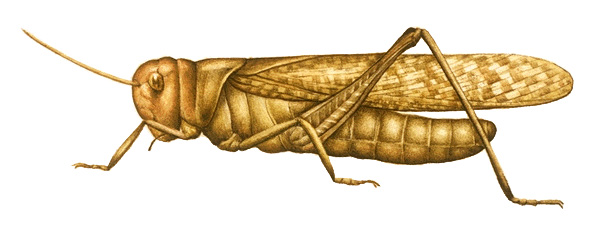Locust usually refers to certain species of grasshopper that can form swarms and migrate . Every continent except Antarctica has its own kind of migratory locust. Certain kinds of cicadas are sometimes also called locusts, but they are not closely related to true locusts.

Most migratory locusts measure about 2 inches (5 centimeters) long. Most of these locusts have a large head, large eyes, and short antennae. They have long hind legs for jumping, and four wings that fold over their backs when they are not flying. Many locusts can make a sound by rubbing their ridged hind legs on their front wings. This rubbing causes the wings to vibrate and makes the noise.
Conditions that cause the migration of locusts are not fully understood. However, scientists know that migration takes place only after a large number of females lay their eggs close together. This may occur because of a food shortage or because of local flooding. The young that hatch from these eggs remain together and live as a group. They meet other groups of young grasshoppers and form a swarm. There may be billions of migratory grasshoppers in a locust swarm. The adults may fly long distances. Wherever they land, they eat and destroy vegetation. Eventually, the locusts become separated. Many generations of solitary locusts may be produced before conditions are right to produce another swarm.
Plagues of crop-destroying locusts have been known since ancient times. One swarm by the Red Sea was believed to cover an area of 2,000 square miles (5,200 square kilometers). The Rocky Mountain locust destroyed millions of dollars worth of crops in the Mississippi Valley between 1870 and 1880. Between 1930 and 1940, migratory grasshoppers caused damage on the Pacific Coast, in the Southwest United States, and on the eastern side of the Rocky Mountains. In 2020, East Africa suffered the largest locust swarms in more than 70 years due to unusually wet weather in the region.
Swarms of migrating locusts are sometimes so large they shut out the sunlight. They interfere with railroad trains and airplanes and make automobile travel dangerous. Millions of crushed locust bodies make rails and highways slippery. Swarms have traveled from Saskatchewan, Canada, to Texas. Others have been seen as much as 1,200 miles (1,930 kilometers) from land.
Scientists and farmers have found several ways to fight locusts. Because grasshoppers lay their eggs in the fall, plowing the soil in the late fall destroys the eggs. When large numbers of grasshoppers hatch, farmers must poison them as soon as possible after hatching. Poison baits or sprays are frequently used.
